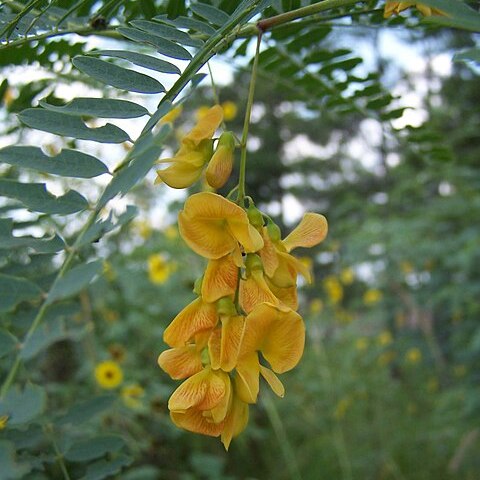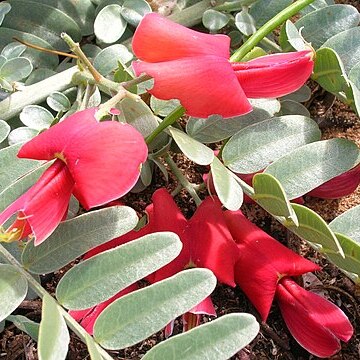Annual or perennial herbs, shrubs, or small trees. Leaves alternate, even pinnate, often relatively narrow in outline and with numerous leaflets; leaflets oblong, entire, obtuse at the apex, rounded at the base, often glaucous, short petioluled; stipules small, deciduous; stipels minute or apparently absent. Info-rescence of relatively short and few-flowered axillary racemes; bracts and brac-teoles small, apparently deciduous. Flowers with the hypanthium broadly cam-panulate, as broad as long or broader, the 5 teeth equal, often short, truncate to triangular with the tip acute to acuminate; often thin; petals white, yellow, pur-plish, red, sometimes white spotted with color or variegated; standard longer than other petals, nearly round in outline, reflexed, short clawed and usually appendaged at the base, the wing petals free, the keel petals curved, joined below, with long claws; stamens diadelphous, the vexillary stamen free, geniculate near the base, the united stamens equal or 5 alternate ones somewhat longer; ovary stipitate, linear, the stigma small, capitate. Fruit often long and slender, terete (in extra-Panamanian species sometimes compressed, 4-angled or 4-winged), short stipitate, beaked, septate between the seeds within, the outside indented between the seeds in some species, 2-valved, indehiscent in a few species, the calyx often not persistent in fruit; seeds many oblong, slightly compressed, smooth, brown.
Corolla glabrous, blue, mauve, white, red or orange, or more commonly yellow with the standard usually streaked and spotted or continuously veined with purple, the claw with two vertical parallel or divergent variously shaped appendages (these rarely lacking, as in S. grandiflora); blade of wing with transverse lamellate sculpturing (except in >i>S.>i>grandiflora), usually toothed or hooked at the base, the claw much shorter than the blade and shorter than that of the keel; blade of keel rounded below, rounded or broadly pointed at the tip, usually toothed at the base, not, or little, longer than the claw.
Cal-tube campanulate to hemispheric, with short, equal, triangular lobes; standard rotund to reniform, short-clawed; wings short-clawed, obliquely oblong-obovate, obscurely auriculate; keel-pet oblanceolate, long-clawed, strongly upcurved, auriculate at base; filaments 10, diadelphous, the tube gibbous at base; fr compressed, linear, the ± numerous seeds separated by transverse partitions; herbs or shrubs with even-pinnate lvs of numerous lfls and short, bracteolate, axillary racemes of yellow fls. 50, warm reg.
Upper stamen free, sharply bent near the base corresponding to the conspicuous auricles at the base of the filament sheath, the sheath longer than the free parts of the filaments which are curved upwards; anthers all alike, oblong-elliptic (much longer than wide in >i>S.grandiflora), dorsifixed.
Leaves paripinnate, the rachis channelled above; leaflets often in more than 10 pairs, oblong, entire; stipels usually present at all petiolules; stipules truncate at the base, occasionally persistent.
Ovary glabrous or rarely pilose with soft spreading hairs; style glabrous or, less often, pubescent near the tip; stigma small, globose or ovoid.
Seeds usually ellipsoid or cylindrical, rarely subreniform; hilum circular or, rarely, broadly elliptical, often surrounded by a narrow rim aril.
Erect annual or briefly perennial herbs or softly woody shrubs or small trees, often producing a dark gummy juice when the bark is cut.
Pod usually long, dehiscent, rostrate, usually shortly stipitate, sometimes winged, transversely septate, (2)4–51-seeded.
Calyx campanulate, usually sparsely woolly at the margin; teeth subequal, shorter than the tube.
Morphological characters and geographic distribution are the same as those of the tribe.
Flowers in axillary racemes; bracts and bracteoles present but often caducous.
Hairs simple, white or golden.


